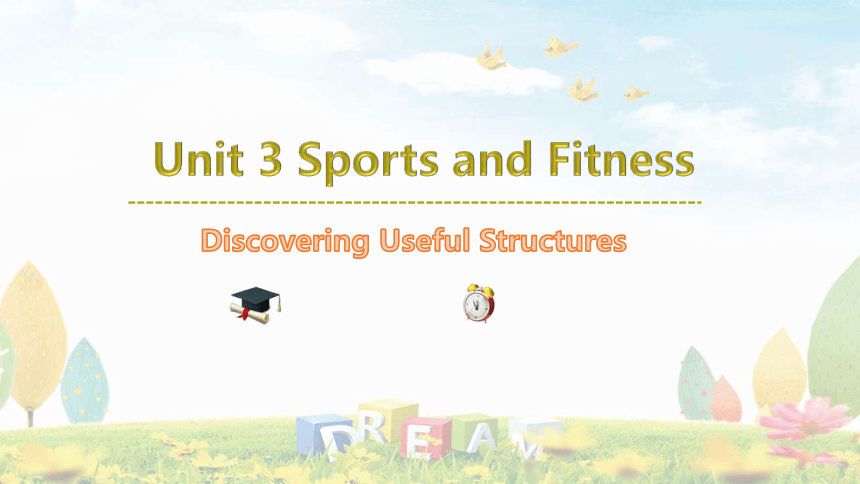(
课件网) Unit 3 Sports and Fitness Discovering Useful Structures 1 Read the conversations below and underline the tag questions and their answers. What functions do the tag questions have 1 Amy: It's not a real sport, is it Shen Qi: Yes, it is. 2 Adam: That sounds interesting, doesn't it Julie: Sure, it does. 3 Lin Tao: Hi It's a beautiful day, isn't it Han Jing: Yes, it is. I'm going to play soccer. Can you come along and join us Lin Tao: Sorry, I can't. I' ve got to meet my adviser,. By the way, our school soccer team won at last, didn't they Han Jing: No, they didn't. Its too bad. _____ _____ _____ _____ _____ _____ _____ _____ The tag questions are used for confirmation. What functions do the tag questions have 反意疑问句 1. 定义 附加疑问句,又称反意疑问句,主要用于口语,其作用是说话人向对方验证自己的陈述或者判断,也可以用于祈使句表示请求或者建议。 Mary wants to be a teacher, doesn't she Don't open your book, will you There's a kite over there, isn't there 2. 基本结构 陈述部分 附加疑问部分 由助动词、be动词或情态动词和表示主语的代词构成。 1.肯定式陈述部分+否定附加疑问部分 3. 分类 You are an actor, He likes soccer, We have ever been to Shanghai, 2.否定式陈述部分+肯定附加疑问部分 It wasn’t fine yesterday, You won’t go to America, aren’t you doesn’t he haven’t we was it will you 1). 陈述部分的主语为somebody, someone, everyone, everybody, no one, nobody 等复合不定代词时,疑问句主语用they或he Someone locked the door, didn’t Everyone has read the book, haven’t Nobody was late, were 注意:关于主语 he they they 2). 当陈述部分主语是指示代词this, that/these, those 指物时,疑问部分主语用 it/they;指人时,疑问句主语用相应的人称代词 That is a new car, Those are our new class buildings, That isn’t your teacher, These are your friends, isn’t it aren’t they is he/she aren’t they 3.含有否定词的陈述部分+肯定附加疑问部分 否定意义的词包括:hardly, never, nothing, few, little, no, seldom, too…to等 4. Few people eat wild animals now, _____ 3. There is nothing important in the newspaper, _____ 2. She has never been to Hong Kong,_____ _____ 例: 1. Mr. Smith can hardly speak Chinese, _____ _____ is there do they has she can he 4. 若陈述部分含有带否定意义,但是由否定前缀组成的词,疑问部分仍用否定式 It is unfair, You dislike singing, She disagreed with you, isn’t it don’t you didn’t she 基本原则:若陈述部分为祈使句,疑问部分通常用will/won’t you 3. Close the door, 4. Don’t make a noise here, 5.祈使句+附加疑问部分 ①陈述句为“Let’s…”结构时,表示“让我们(你我双方)”附加问句一般用 “shall we ” ②陈述句为“Let us…” 结构时,表示“你让我们...”, 附加问句一般用 “will you ” 1. Let’s go home, _____ 2. Let us go home, _____ shall we will you will / won’t you will you 6.情态动词+附加疑问部分 当陈述部分含有情态动词时,疑问部分会重复前面情态动词。 例: 1. He can play the piano, _____ 2. We shouldn't go right now, _____ 3. They can’t finish it, _____ can't he should we can they Discovering Useful ... ...

